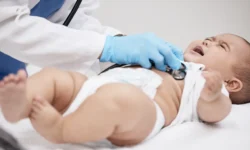What if a premature delivery causes a baby problems later in life?
Most pregnancies last around 40 weeks gestation. When a single infant is born before 37 weeks gestation, the baby is considered premature. Multiple birth pregnancies (twins, triplets, etc.) are considered full-term at 36 weeks.
Premature delivery of a baby is not uncommon. But what’s less understood is the host of health complications, risks, and birth injuries that can result. In general, the earlier the baby’s delivery, the more at-risk they are for being born with a range of health conditions. Of course, some premature babies sometimes die at birth, which is the worst injury of all. Thanks to medical technology, many “premies” survive, but they may suffer from lifelong conditions.
In this article, we discuss what causes premature birth, how to prevent premature birth and the impact of premature baby problems later in life.
What causes premature birth?
Some, but not all, of the causes of premature birth are well known and documented. For example, a previous premature birth and multiple infant pregnancies both increase the risk of premature birth. If the mother is older or younger than average, has an infection while pregnant, or uses drugs or alcohol, then premature birth is also more common.
Preterm birth is often considered a medical emergency. In most instances, premature birth is unavoidable. In approximately 50 percent of cases, the reasons for a premature delivery are unknown. Early rupture of fetal membranes is known to initiate the process of preterm labor and delivery.
Other factors may place a pregnant woman at greater risk of having a premature delivery, including:
- Placental abruption. Normally, the placenta is affixed to the uterine wall during pregnancy, where blood vessels deliver vital nutrients and oxygen to the fetus. When placental abruption occurs, the placenta detaches from the mother’s uterus. Bleeding may result.
- Multiple births. A multiple-infant pregnancy (twins, triplets, etc.) increases the mother’s risk of premature birth. About 50 percent of twins are delivered at or before 36 weeks. About 50 percent of triplets are delivered before 32 weeks. Premature labor may start spontaneously but, if there are complications, it may be induced by the doctor.
- Hormone changes. Increasing or decreasing hormones may create stress on the unborn and/or mother, thus increasing the risk of an early delivery.
- Infection. While the mother is recovering from or has an active infection during pregnancy, premature birth is a risk. For example, an untreated urinary tract infection (UTI) or bacterial vaginosis has been shown to double the mother’s risk for premature birth. Obstetricians typically screen for these infections at every medical visit. These infections are typically treated with antibiotics.
- Prior premature labor. The mother’s chance of premature birth increases 2.5 times if she previously delivered a premature infant. The rate climbs ten-fold if the prior premature labor happened before 28 weeks gestation.
- Medical problems. Maternal conditions like anemia or slow weight gain, and lifestyle factors, (e.g. high stress or work habits, alcohol, and drug use) are all possible risk factors for premature birth. Regular doctor visits and lifestyle changes during pregnancy can improve the mother’s risk of delivering a premature infant.
- Maternal age. When a mother is pregnant below the age of 17 years or above the age of 40, the risk of early delivery is higher.
- Incompetent cervix. If the mother’s cervix slowly dilates before the estimated time of delivery, this is known as cervical incompetence (or insufficiency). This condition can result in a preterm birth if not properly treated.
How to prevent premature birth
Sometimes a premature birth is unpreventable, regardless of what preventative steps parents or doctors take. However, certain lifestyle choices can increase the chances of premature birth. It’s possible to change some behaviors to encourage a healthy, full-term pregnancy and delivery.
- Don’t smoke. Quit smoking before you become pregnant or as soon as possible if you become pregnant.
- Don’t use recreational drugs or drink alcohol during pregnancy.
- Tell your doctor about all medicines you take, including over-the-counter medicines and vitamins, as some drugs may harm your baby (like Zofran).
- Gain enough weight during pregnancy, but avoid gaining too much weight. Gestational diabetes is another risk factor for premature birth.
- Eat a healthy diet. Nutrition is important when pregnant, regardless of your age. Take prenatal vitamins if advised by your doctor.
- Avoid strenuous physical labor.
- De-stress your life. Consider starting gentle exercise (yoga) and relaxation practices (mediation).
- Attend prenatal classes.
- Practice good hygiene to avoid infections.
- Notify your health care provider if your history includes premature birth.
- Surgically correct any known structural abnormalities of the uterus before pregnancy.
- Surgically correct an incompetent cervix at approximately 14 weeks gestation to avoid premature delivery.
- Discuss chronic illnesses with your doctor. Some illnesses, if unmanaged, promote premature labor and delivery.
- Consult your doctor or nurse practitioner if you’re considered at high risk for premature birth.
Long-term effects of premature delivery
Premature infants are at higher risk of both perinatal (immediately before and after birth) and neonatal (newborn) health problems and birth injuries. A premature birth means that the baby’s body isn’t completely developed. As a result, the baby is at higher risk for serious health complications that may affect them for life.
Undeveloped or underdeveloped lungs
The lungs are among the last organs to fully develop in utero. In most cases, the infant’s lungs aren’t fully developed until (at least) 36 weeks’ gestation. A premature baby’s lungs might not work well enough to supply the baby’s body with enough oxygen. If the baby’s lungs aren’t properly functioning at birth, they may suffer a brain injury due to a lack of oxygen.
An infant’s lung development is the big question in premature birth. Many complications and risks of premature baby problems later in life result from under-developed lungs.
Respiratory distress syndrome (RDS)
A premature infant may suffer from RDS, which is a respiratory condition that occurs because the premie’s lungs lack sufficient pulmonary surfactant (a specific protein that keeps the lungs inflated). Newborns with RDS can’t breathe normally on their own, so it may be necessary to treat the baby with a respirator or ventilator.
Bronchopulmonary dysplasia (BPD)
BPD occurs when a premature baby is placed on a ventilator for longer periods (1+ months). Pressure from the ventilator can permanently damage the baby’s lungs.
Neonatal pneumonia
A premature infant born with undeveloped or underdeveloped lungs is also at risk of developing neonatal pneumonia after birth. This inflammatory infection may permanently disrupt the lungs’ ability to exchange oxygen for carbon monoxide.
Timely diagnosis of pneumonia may be treated with antibiotics and long-term injury avoided. Unfortunately, if neonatal pneumonia is undiagnosed, the child may suffer lifelong problems as a result.
Infection
A premature baby’s immune system is less capable of defending against many infections. For this reason, the newborn may be moved to the hospital’s Neonatal Intensive Care Unit (NICU).
Anemia
Anemia, which is when the blood lacks enough red blood cells, commonly occurs in premature babies. Blood cells are essential to circulating oxygen throughout the body. In some instances, the baby may need blood transfusions to correct the problem.
Gastrointestinal tract immaturity
A premature infant’s gastrointestinal and digestive tracts may be under-developed. Some premature babies have difficulty processing and absorbing the nutrition they need from baby formulas or breast milk. For this reason, many premature babies receive intravenous nourishment in the NICU.
Patent ductus arteriosus (PDA)
Some premature babies have a heart problem called patent ductus arteriosus (PDA). This problem occurs because a blood vessel doesn’t fully close before the baby’s birth. The vessel acts as a valve that separates 2 other major cardiopulmonary vessels. While the baby is in utero, the valve is open to encourage lung development. In the final stages before a full-term birth, hormones facilitate the closure of the ductus arteriosus.
In the pre-term baby, PDA may cause blood to flow into under-developed lungs at birth. When fluid collects in the lungs, the baby can suffer heart failure. Doctors treat PDA with synthetic hormones, allowing the vessel to close.
Intraventricular hemorrhage (IVH) and “brain bleeds”
Very premature infants, born at 34 weeks gestation or less, may lack fully developed blood vessels to the brain. The infant’s immature circulatory vessels are more prone to rupture and tear, especially if the child experiences a stressful vaginal delivery. This type of brain vessel rupture is called IVH. Brain bleeds in premature babies may result in permanent brain damage and/or result in cognitive delays and life-long disabilities.
Premature birth and birth injury lawsuits
An infant may be born prematurely because of a known or unknown trigger. Often, premature birth means something went awry, but it doesn’t always mean that a healthcare provider is to blame. For example, doctors may have forced a premature birth to save the infant’s life.
However, in some cases, medical negligence played a role in an early birth and the resulting injuries.
Premature birth increases the child’s risk for brain damage, cerebral palsy (CP), periventricular leukomalacia (PVL), developmental delays, and a host of other lifelong conditions.
For legal help regarding premature birth and birth injuries, contact Brown Trial Firm. Our birth injury lawyers help parents and children nationwide recover just compensation for medical negligence.
- Cerebral Palsy
- Caput Succedaneum and Cephalohematoma
- Neonatal Intracranial Hemorrhage (Childbirth Brain Bleeds)
- Hydrocephalus (Extra Fluid in the Brain Cavity)
- Cervical Dystonia
- Hemiplegia (Brain or Spinal Cord Injury)
- Hemorrhagic Stroke
- Neonatal Stroke
- HIE
- Periventricular Leukomalacia (PVL) Brain Injury
- Infant Seizures
- Spastic Diplegia (Spasticity in the Legs)
- Top Risks for Birth Injuries
- Fetal Alcohol Syndrome
- Facial Paralysis
- Spinal Cord Injuries
- Bell’s Palsy
- Brachial Plexus Nerves & Erb’s Palsy
- Klumpke’s Palsy
- G-Tubes for Newborns
- Medical Errors
- Cesarean Section & Birth Injury
- Negligence in Brain Cooling Treatment
- Craniosacral Therapy
- Occupational Therapy
- Speech Therapy
- Transition From Pediatric to Adult Healthcare
- Surgical Options for Spastic Cerebral Palsy
- Fetal Intolerance to Labor
- Jaundice (Kernicterus)
- Breech Position
- Placental Complications
- Umbilical Cord Problems
- Uterine Rupture
- Cervical Incompetence (Insufficiency)
- Blighted Ovum
- Necrotizing Enterocolitis (NEC) - Intestinal Inflammation
- Cephalopelvic Disproportion
- Meconium Aspiration Syndrome
- Amniotic Fluid Embolism
- Birth Injury from Premature Delivery
- Developmental Delays
- Abnormal Cord Insertion
- Infections at Birth
- Chorioamnionitis Bacterial Infection
- Premature birth
- Oxygen Deprivation
- Listeria
- Birth-Acquired Herpes
- Placenta Previa
- Placental Abruption
- Mismanaged Fetal Malposition
- Rapid Labor
- Obesity Related Birth Injuries
- Intrauterine Growth Restriction
- Blood Clots During Pregnancy
- Ectopic Pregnancy Misdiagnosis
- Myths & Facts About Birth Injuries
- Bacterial Vaginosis
- Gestational Diabetes
- Maternal Mortality Risk
- Oligohydramnios (Low Amniotic Fluid)
- Infections During Pregnancy
- Excessive Bleeding During Pregnancy
- Congenital Syphilis


